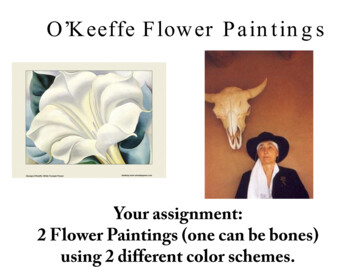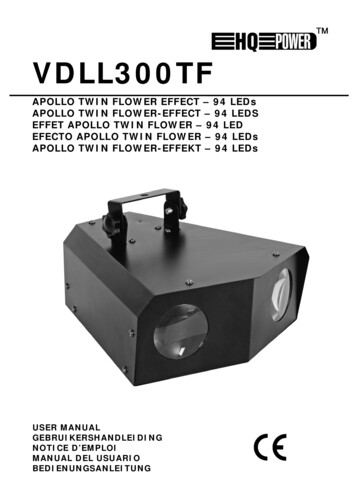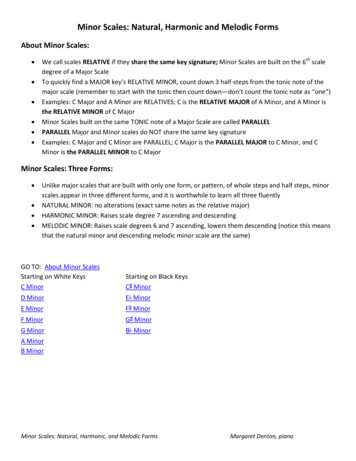
Transcription
O’K eeffe F low er P a in t in g s
“Georgia O’Keeffe: A Portrait,”Photo by Alfred Stieglitz, 1918.“Georgia O’Keeffe: A Portrait,”Photo by Alfred Stieglitz, 1922
1. Georgia O’Keeffe:Focused on transforming nature intoabstraction. Known for close-ups offlowers & cow bones
This is an abstracted landscape paintingCottonwood III, 1944
Qualities of Georgia O’Keeffe’s Paintings NaturalisticAbstractOrganic ShapesWarm ColorsCool ColorsMoodyYellow OrchidGeorgia O’Keeffe
F a ct s on Ge org i a O’Ke e ffe : Bor n in Su n P r a ir ie, Wis con s in ;Moved t o N ew Mex ico in 1 9 4 9 St u d ied a t t h e Ar t In s t it u t e of Ch ica g o a n d a tt h e Ar t St u d en t s ’ Lea g u e of N ew Yor k . K n ow n for h er p u r it y of for m , clos e-u p view sof flow er s & cow bon es Us ed h er a r t t o ex p r es s id ea s a n d s en s a t ion st h a t s h e cou ld n ot ex p r es s t h r ou g h w or d s . O’K eeffe’s ca r eer s p a n n ed t h e en t ir e p er iod ofm od er n a r t .
“Nobody sees a flower really; it is so small. Wehaven't time, and to see takes time like to havea friend takes time.” Georgia O’KeeffeWhite Trumpet FlowerWhat does O’Keeffe mean by this quote?
Georgia O’Keeffestarted drawing &painting with“NaturalisticRepresentation”
Apple Family Still life:Characteristics:organic shapes,warm colors,blendingValuecontrast
O’Keeffe’s flowers gradually went from naturalisticrepresentations to less realistic looking abstractions.They represent the beauty she saw in nature.
“Calla Lilies,” 1924.
“Red Canna,” 1923.
“Petunia,” 1925.
“Blue Flower,” 1918.
“She portrayed the world simply as shesaw it and her vision had many unusualperspectives. Flowers were her favoritesubjects and she would sometimes paintflowers very close-up or very far away, orsometimes she would only show us a partof her subject on the canvas. She gave usthis new perspective because she wantedto make us look at the beauty of flowersin a new way.”
“Series I – From the Plains,” 1919. Abstract ion of Texas’swide skies and fiercestorms that underscoresthe sense of creativeindependence she hadknow there.
“Out Back of Marie’s II”, 1930 This painting consists ofintense colors, sharpcontrasts, andextraordinarily delineatedcontours of NewMexico’s landscape.
Ram’s Head, Blue Morning Glory,” 1938, “The hard, intricate shapesof an animal’s skull andhorns are offset by the soft,relatively simple petals of aflower. By juxtaposing twovastly different subjects forwhich she had becomefamous – flowers & skulls– O’Keeffe wittily impliesthat they arecomplementary forces innature. “
“Pelvis Series, Red with Yellow,” 1945. O’Keeffe collected cowbones from the NewMexico landscape andpainted some of themwith wild abstract colors.
A series that represent O’Keeffe’s thoughts and emotions.How might these paintings convey emotion?GEORGIA O’KEEFFESeries I: No. 1, No. 3 and No. 4
Why flowers?Geor g ia O’K eeffe St a t es :“A flow er is r ela t ively s m a ll. E ver y on e h a sm a n y a s s ocia t ion s w it h a flow er.You p u t ou t y ou r h a n d t o t ou ch t h e flow er - lea nfor w a r d t o s m ell it -m a y be t ou ch it w it h y ou r lip sa lm os t w it h ou t t h in k in g - or g ive it t o s om eon et o p lea s e t h em .St ill ,in a w a y, n obod y s ees a flow er, r ea lly, it iss o s m a ll – w e h a ven ’t t im e a n d t o s ee t a k es t im e,lik e t o h a ve a fr ien d t a k es t im e.If I cou ld p a in t t h e flow er ex a ct ly a s I s ee it n oon e w ou ld s ee w h a t I s ee beca u s e I w ou ld p a in tit s m a ll lik e t h e flow er is s m a ll. So I s a id t om y s elf – I’ll p a in t w h a t I s ee – w h a t t h e flow er ist o m e bu t I’ll p a in t it big a n d t h ey w ill bes u r p r is ed in t o t a k in g t im e t o look a t it – I w illm a k e even bu s y N ew Yor k er s t a k e t im e t o s eew h a t I s ee of flow er s .”
Oleg Turchin – contemporary artist.
Mrs. Meisner’sExamples(Inspired byOkeeffe):
Mrs. Meisner’s examples fromObservation
Paint in Layers!
Painting from Observation:Photo of flowers I Painted fromMy interpretation of the tulips
Layers & Blending in Oil
Adding a Background:
Taking Photos is a good way to finda good composition:
Bones!
INTERESTING FACTDid you know watercolor is spelled 2 ways?WATERCOLOR- AmericanWATERCOLOUR- British
WATERCOLOR TECHNIQUES1. Color wheel – Y, O, R, P, B, G2. Wash – Wet watery paint; Translucent3. WET ON WET - using wet watery paint onwet paper.4. WET ON DRY - wet paint on dry paper.5. DRY ON DRY - paint with little water ondry paper.
Examples
More techniques 6. DRY ON WET - dry brush with little wateron wet paper.7. LIFTING OFF - applying wet paint to drypaint and blotting with a paper towel to liftoff paint.8. DROPPING IN COLOR - adding color to awet area; let it blend/bleed & spread9. Fade, Blend, Value scale10. Modeled 3D objects – Making somethinglook 3D with tints & shades
Examples
FADE OR BLEND - TechniquePainting 2 colors next to one another and letting them blendtogether.
VALUE GRADATIONUsing black or another color to make a color darker, or using more water tomake a color ercise-in-gradation.html
COLOR SCHEMES – combinations ofcolors that create a certain mood1. Warm Colors2. Cool Colors3. Complimentary4. Analogous5. Monochromatic
WARM: red, orange and yellowGeorgia O'Keeffe Paintings Oriental Poppies,1927
COOL: blue, green and purpleGeorgia O'Keeffe Paintings Black and PurplePetunias
COMPLIMENTARY COLORSColors that are opposite on the color wheel.Red & Green. Blue & Orange. Yellow & Purple.
ANALAGOUS COLORSColors that are side by side on the color wheel.painting.about.com/./ ppfruit-MSutton.htm
MONOCHROMATICA single color with tints and shades.www.creationartist.com/ 2008/11/color-schemes/
Stop here.
SKETCHBOOK PRACTICE 2 Sketch Book Pages 1st Page– Separate into 6 sections.– Choose 6 watercolorTechniques to practice.Wet on wetWet on dryDry on dryDry on wetLifting offDropping incolor 2nd Page– Separate into 6 sections– Choose 6 color schemes topractice.
Basics of Drawing flowers 1. Draw a rectangle border.2. Lightly sketch out the basic shapes.3. Modify stem, leaves, & petals to be in proportion4. Shade in light, medium, & dark areas5. Add details & color last. Use fades & blends.
1. Zoom out –Lots of background space orMultiple flowers.
2. Zoom in – Flower fills the entirespace. Some background is seen
3. Zoom in more – Crop the flowerthe flower goes beyond the space
4. Extreme close up or Abstraction
Directions:1. Draw oversized, organic shapes forflowers in pencil.2. Paint a medium value color all overflower. Then paint background adarker or lighter value.3. Add tints (lights) and shades (darks)4. After it’s dry, add final darkest darksnext to lightest lights for HIGHCONTRAST!
PAINTING TIPS! Always put your name 1st. LIGHTLY SKETCH design in pencil first. PAINT IN LAYERS– 1ST Paint bottom layers– 2nd Paint middle layers– 3rd Paint details/textures BRUSHES– BIG for large spaces– MEDUIM for medium spaces– SMALL for details
WATERCOLOR TECHNIQUES 1. Color wheel – Y, O, R, P, B, G 2. Wash – Wet watery paint; Translucent 3. WET ON WET - using wet watery paint on wet paper. 4. WET ON DRY - wet paint on dry paper. 5. DRY ON DRY










